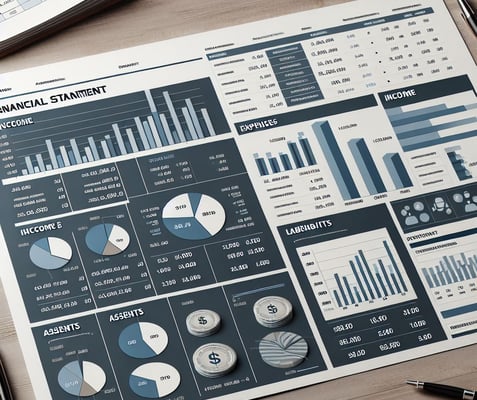"Unlock the secrets to smart investing and stay informed on the latest trends in Indian business and finance."
Inventurus Knowledge Solutions IPO
If you are seeking investment opportunities, investing in Inventurus Knowledge Solutions could offer high profitability potential.
CA Narendra Rajpoot
12/15/202411 min read
1. About the Company..
Inventurus Knowledge Solutions (IKS) is a technology focused provider of healthcare solutions, offering a care enablement platform. The company serves physician enterprises primarily in the United State, as well as in Canada and Australia. IKS supports both outpatient and inpatient care providers. The company's platform is designed to cater to outpatient services, which encompass medical treatments such as observations, consultations, diagnoses, rehabilitation, interventions, and treatments - all provided without requiring hospital admission. Additionally, IKS addresses the needs of inpatient care, where patients receive medical attention that necessitates an overnight stay or extended hospitalization.




2. Strengths
As of September 30, 2024, IKS served 778 healthcare organizations, including health systems, academic medical centres, multi-specialty and single specialty medical groups, ancillary healthcare providers and various outpatient and inpatient care organizations.
IKS's client base includes notable organizations such as Atlanta Women's Health Group, Boston Children's Health Physicians, Hanger Inc.., US Digestive Health (GI MSO Inc.), Lehigh valley Health Network, Light beam Health solutions, Mass General Brigham, MEPG, Professional Occupational and Physical Therapy, Sema4, Spear Physical Therapy, Texas Health Care PLLC, The GI Alliance Management, Duke Health, McLaren, Maxim Health Services, Providence, Thunder mist Health Centre.
IKS offers a digital health platform designed to help clients optimize their technology systems. Its Unifying Data Platform(UDP) enables the integration of data from multiple sources, including billing systems, electronics health records (EHRs), and clearinghouses, into a centralized database. This eliminates the need for EHR or billing system migrations and reduces capital expenditure, providing clients with streamlined access to actionable insights for effective decision making.
With the acquisition of Aquity Holding on October 27, 2023, IKS expected its capabilities in clinical documentations, medical coding, and revenue integrity solutions. This acquisition allows IKS to cross-sell its solutions to Acuity's existing customers base of over 804 healthcare organizations(as of march 31,2024), significantly broadning its market opportunities.
IKS delivers innovative proprietary platforms that enhance healthcare operations: like IKS EVE(a multi channel patient access and engagement solution.), Optimix (a workflow management platform focused on revenue optimization), IKS stacks (a platform that uses OCR, NLP, and proprietary algorithms to extract data from clinical documents), and IKS Scribble (a solution combining automation, AI, and human expertise to create medical notes for physicians).
IKS States that the company leverages RPA to automate repetitive and structured tasks within virtual environments. This includes routine payer interaction, claims rebilling, eligibility inquiries, and claim status tracking through payer websites. These automated processes increase efficiency and reduce operational burdens for healthcare organisations.
The company has been a consistent increase in revenue from operations and profit after tax(PAT). Revenue from operations increased from Rs. 763.63 crore in FY22 to Rs. 1031.3 crore in FY23 to Rs. 1817.93 crore in FY24. PAT increased from Rs. 232.97 crore in FY22, to Rs. 305.23 crore in FY23 to Rs. 370.49 crore in FY24.


3. Risks
IKS is currently involved in certain legal proceedings. Any adverse judgement in any of the cases could be detrimental to the company's business prospects.
IKS success depends on its ability to develop and launch new solution based on artificial intelligence(AI) and machine learning(ML). If the company fails to enhance existing offerings such as AI-powered speech to next solutions, there could be a negative impact on its revenues, operational results, and market reputation.
IKS operate in the highly competitive US healthcare market where balancing quality care and cost efficiency poses challenges. Additionally, the consolidation of healthcare organization in the US may affect its business performance and financial stability.
IKS revenue depends on its ability to retain existing clients and attract new ones. As of September 30,2024, the company had 778 clients contributing Rs. 1282.88 crore in revenue. In prior years, IKS had 853 clients in FY24 contributing Rs. 1817.93 crore, 49 client in FY23 contributing Rs. 1,031.3 crore, and 45 clients in FY22 contributing Rs.763.63 crore. The loss of one or more major clients could significantly affects IKS financial condition of operations.
A large portion of IKS revenue is generated from healthcare organisations in the united states. US clients contributed Rs. 649.30 crore (99.94%) in the six months ended September 30,2024, and Rs. 1,265.94 crore (99.94%), Rs. 1,054.97 crore (99.93%), and Rs. 744.58 crore (99.91%) to the company's revenue from operations in FY24, FY23, and FY22, respectively. Any adverse development in the US healthcare sector or any political, social, or economic disruption could harm the company's operations and finances.
IKS generates a significant portion of its revenue from a small number of clients. The top 10 customers contributed Rs. 441.20 crore (34.39%) in the six months ending September 30, 2024, and Rs. 793.65 crore (43.66%), Rs. 691.87 crore(67.09%), and Rs. 520.50 crore (68.16%) to the revenue from operations in FY24, FY23, and FY22, respectively. Any loss of these major clients or a reduction in business from them could hurt the company's revenue generation capabilities.
A large portion of IKS revenue is generated through its subsidiaries, particularly IKS Inc. and Aquity solution, LLC, which together accounted for over 27% of revenue in fiscal 2024. Any financial instability or legal restrictions affecting these subsidiaries could adversely impact IKS revenue and financial condition.
As of September 30,2024, IKS had total outstanding borrowing of Rs. 835.85 crore. Any inability to repay or service these loans could harm the company's financial position.


4. About the financials..
Net profit - The company's net profit has been consistently growing year on year. It was Rs. 233 crore in March 2022, Rs. 305 crore in March 2023, and Rs. 370 crore in March 2024, with Rs. 209 crore recorded by September 2024.
The steady growth in net profit from ₹233 crore in March 2022 to ₹370 crore in March 2024 suggests the company has been performing well, either by increasing its revenues or improving its cost structure. However, the decline in profit for the first half of FY2024-25 (₹209 crore as of September 2024) is noteworthy and warrants further analysis.
The drop in profit could be attributed to temporary factors, seasonal trends, or one-off expenses, but it will be important to monitor whether this trend continues into the second half of the year. The company’s ability to manage costs, adapt to market conditions, and sustain its growth strategies will be critical for maintaining profitability in the future.
Market Capital - Market capital of the company is Rs. 22,802 crore.
Reserves - Company is focusing on increasing the reserves. Reserves of the company was Rs 630 crore in March 2022, and was Rs. 812 crore in March 2023, and was Rs. 1,141 crore in March 2024. and was Rs. 1,360 crore till Sep 2024.
When the reserves of a company are increasing, it generally means that the company is setting aside more of its profits for future use rather than distributing them as dividends to shareholders. Reserves are typically accumulated in a company’s balance sheet under "Shareholders' Equity" and can serve various purposes.
Borrowings - The company is focused on growing its reserves. Reserves were Rs. 630 crore in March 2022, Rs. 812 crore in March 2023, Rs. 1,141 crore in March 2024, and Rs. 1,360 crore as of September 2024.
The borrowings data indicates significant fluctuation in the company's debt levels within a short time frame. While the increase in borrowings from March 2023 to March 2024 could point to aggressive expansion or investment strategies, the decrease in borrowings in the following months suggests the company is managing its debt carefully, possibly to improve financial stability and reduce financial risk. Further analysis of the company's financial statements (e.g., cash flow, earnings, debt servicing) would provide more insight into the reasons behind these changes.
Other liabilities - The company's other liabilities were Rs. 107 crore in March 2023, Rs. 411 crore in March 2024, and Rs. 479 crore in September 2024.
The increase in other liabilities reflects a significant change in the company's financial obligations, particularly from March 2023 to March 2024. The company may be deferring payments, accruing provisions, or recognizing new obligations. While this is common in growing companies, it is essential to monitor how these liabilities evolve over time and whether they are being managed prudently. As with borrowings, it would be useful to understand the specific nature of these liabilities in the company's financial statements to assess their impact on overall financial health.
Fixed Assets - Fixed assets of the company was Rs. 788 crore in Mar 2022, and was Rs. 988 crore in Mar 2023, and was Rs. 2,880 crore in Mar2024 , and was Rs.2,791 crore in Sep2024.
The increase in fixed assets from March 2023 to March 2024 is substantial, suggesting that the company has made significant investments, likely for expansion, upgrades, or new projects. The slight decline in fixed assets by September 2024 could be due to depreciation or disposals. These changes in fixed assets indicate that the company is actively investing in its long-term future, but it will need to ensure efficient use and management of these assets to maximize returns and avoid any unnecessary financial strain.
To understand the precise nature of these investments, further analysis of the company's cash flow statements and Capex breakdown would provide more clarity on how these fixed assets are being financed and utilized.
Investment - The company's fixed assets were valued at Rs. 788 crore in March 2022, Rs. 988 crore in March 2023, Rs. 2,880 crore in March 2024, and Rs. 2,791 crore in September 2024.
The increase in investments from ₹32 crore in March 2023 to ₹195 crore in March 2024 highlights that the company is likely in a growth phase, making significant capital investments in infrastructure, expansion, or acquisitions. The sharp decline in investments by September 2024 indicates a shift in focus, either due to the completion of major projects or a more cautious approach to spending.
The company’s ability to manage these investments effectively and ensure they translate into profitable returns will be critical for long-term success. It will also be important to assess the reasons for the slowdown in investments—whether it's due to market conditions, financial prudence, or a strategic realignment—to determine the future growth trajectory of the company.
Other Assets - The company's other assets were Rs. 898 crore in March 2023, Rs. 849 crore in March 2024, and Rs. 943 crore in September 2024.
The changes in Other Assets show both a decrease in the period from March 2023 to March 2024, followed by an increase in the period from March 2024 to September 2024. These fluctuations suggest that the company is actively managing its non-core assets, possibly reducing its exposure to certain long-term investments or liabilities, and then increasing them again by investing in new or strategic long-term assets.
The decrease in March 2024 might reflect disposals, write-downs, or reclassification of assets, while the increase in September 2024 could suggest new investments or strategic acquisitions that will benefit the company in the future.
The company’s ability to manage and optimize its other assets will be crucial in maintaining a balance between liquidity, long-term growth, and profitability. The changes in these assets can have significant implications for both short-term financial flexibility and long-term strategic positioning. Monitoring how these assets contribute to the company’s overall financial performance will be key to understanding its future trajectory.




5. Cash Flow
Cash from Operating Activity - Cash generated from operating activities amounted to Rs. 233 crore in March 2022, Rs. 288 crore in March 2023, and Rs. 210 crore in March 2024.
The company's cash from operating activities increased from ₹233 crore in FY2022 to ₹288 crore in FY2023, reflecting a positive trend in operational efficiency or revenue generation. However, the decline in FY2024 to ₹210 crore suggests a weakening in operational cash flow, which could be due to lower profits, higher working capital needs, or increased costs.
The company will need to investigate the reasons behind this decline and assess whether it is a temporary issue (such as higher inventory or one-time costs) or part of a longer-term trend. Improving working capital management, controlling operating costs, and ensuring strong revenue growth will be key to reversing this decline and maintaining healthy operating cash flow in the future.
Cash from Investing Activity - Cash used in investing activities was Rs. (82) crore in March 2022, Rs. (158) crore in March 2023, and Rs. (1,137) crore in March 2024.
The company’s cash from investing activities has significantly increased over the past few years, from ₹(82) crore in FY2022 to ₹(1,137) crore in FY2024. This large increase in outflows suggests a shift toward aggressive investing activities, such as acquisitions, large capital expenditures, or strategic investments in long-term assets.
While these investments may provide long-term growth and expansion, they have temporarily reduced the company’s liquidity and cash flow. If these investments are financed through debt, the company will need to manage its debt obligations carefully. The company will also need to monitor the return on investment (ROI) of these expenditures to ensure that they generate adequate returns in the future, thus ensuring that the cash outflows are ultimately beneficial for long-term profitability and growth.
Overall, the sharp rise in cash outflows reflects a growth-focused strategy, but it will be essential to assess whether the investments made in FY2024 translate into increased revenue or operational improvements in the coming years.
Cash from Financing Activity - Cash used in financing activities was Rs. (59) crore in March 2022, Rs. (152) crore in March 2023, and Rs. 780 crore in March 2024.
The cash from financing activities data suggests that the company shifted its financing strategy over the past few years:
In FY2023, the company had negative cash flow from financing activities, reflecting an emphasis on debt repayment or reducing financial obligations.
In FY2024, the company turned around with a substantial inflow of ₹780 crore from financing activities. This likely indicates increased borrowings or possibly equity issuances to raise funds for growth initiatives, acquisitions, or capital expenditures.
While the increase in financing activities in FY2024 could support future growth, it also indicates a rise in financial leverage, which needs careful management. The company will need to ensure that the funds raised are used efficiently to generate returns that exceed the cost of financing and service any debt obligations. The success of these investments will be key to whether this strategy enhances shareholder value in the long term.


6. Ratios
Debtor Days - Debtor days were 46 days in March 2022, 57 days in March 2023, and 73 days in March 2024.
The increase in debtor days from 46 days in March 2022 to 73 days in March 2024 suggests that the company is taking longer to collect payments from its customers. The growing trend of delayed payments can result in deteriorating cash flow and liquidity issues, making it harder for the company to meet its operational and financial obligations.
Cash Conversion Cycle - The cash conversion cycle was 46 days in March 2022, 57 days in March 2023, and 73 days in March 2024.
The Cash Conversion Cycle has steadily increased from 46 days in March 2022 to 73 days in March 2024, signaling that the company’s working capital is tied up for a longer period. This increase in CCC can be attributed to longer debtor days (DSO) and possibly inventory management inefficiencies. While the company may be pursuing growth strategies that involve more credit sales or larger contracts, the rising CCC indicates potential liquidity and cash flow challenges.
Working Capital Days - Working capital days were 21 days in March 2022, 26 days in March 2023, and 6 days in March 2024.
The working capital days have significantly decreased from 26 days in March 2023 to 6 days in March 2024, signaling a dramatic improvement in the company’s ability to manage its working capital. This reduction suggests that the company is efficiently converting its working capital into cash, which positively impacts its liquidity, cash flow, and financial health.
ROCE % - The ROCE% was 47% in March 2022, 50% in March 2023, and 30% in March 2024.
- The ROCE data indicates a positive trend from 47% in March 2022 to 50% in March 2023, showing improved efficiency in utilizing capital. However, the significant decline to 30% in March 2024 raises concerns about diminishing returns on capital. This could be attributed to:
- A substantial increase in capital employed (likely due to rising fixed assets).
- A potential decrease in EBIT or operational inefficiencies.
Stock PE Ratio - Stock PE ratio is 61.6.
A P/E ratio of 61.6 is relatively high, indicating that investors are expecting strong growth or are willing to pay a premium for the company's stock.
ROE - ROE of the company is 37.3%.
A ROE of 37.3% is an excellent performance, reflecting that the company is using its equity capital very efficiently to generate profits. It suggests:
Strong profitability and operational efficiency.
Potential for high returns for investors.
The company is likely performing better than many of its competitors, assuming this ROE is higher than the industry average.
Dividend Payout % - The dividend payout ratio was 393% in March 2022, 0% in March 2023, and 46% in March 2024.
2022 (393%): The very high payout ratio was likely due to an exceptional situation, potentially involving one-time events or excess reserves.
2023 (0%): The company skipped dividends, likely focusing on preserving capital due to financial needs or strategic goals.
2024 (46%): The company adopted a more sustainable and reasonable dividend policy, which seems to be a positive sign of financial stability and responsible management.


